Helsinki energy decision options 2015: Difference between revisions
m (→Vuosaari) |
|||
| (17 intermediate revisions by 4 users not shown) | |||
| Line 83: | Line 83: | ||
|} | |} | ||
Same table as in VE2(?), because same power plants will be in use. | Same table as in VE2(?), because same power plants will be in use. | ||
== Helen's suggestion: New heat plants == | |||
Helen's new option in June 2015: a distributed model based on separate heat production | |||
* The investments necessary are flexible and distributed solutions | |||
* The oil heat plant in Salmisaari is replaced by a new about 100 MW pellet heat plant, what can be taken into use in 2017. | |||
* A new bio heat plant is built in Vuosaari and possibly also somewhere else. | |||
* The bio heat plants use pellets and/or wood chips as fuel. The use of biocoal is also possible. | |||
* The option enables different energy efficiency solutions and new ways to produce heat (heat pumps, solar heat, geothermal heat...), that are taken into use slowly as the conditions change to enable their use. Both Helen and other, for example home-owners, can take these new technologies into use. | |||
* The option helps achieve the goals for reducing emissions and increasing renewable energy. | |||
* The challenges to increasing the use of biofuels have to do with their availability, acceptability and price. | |||
* The option is somewhat against the city council's energy policy, because it replaces CHP with the separate production of heat. Helen still thinks this is a feasible option in the future's energy markets. According to international analysis data the price for electricity will remain so low for so long new investments in CHP isn't worth it. Even with this option Helen is left with a lot of CHP capacity, so the decrease in CHP would remain relatively small. | |||
* The option includes the possibility to built a CHP plant in Vuosaari in the future. | |||
* When the bio heat plants are taken into use and the necessary heat production capacity is ensured in the beginning of 2020's, it is possible to give up the Hanasaari CHP plant. If this is done, the majority of the plant area would be freed for other uses. Also the bridge between Sompasaari and Kruunuhaka could be built. | |||
* According tothe environmental impact assessment the option is feasible. | |||
* The investments required by the option are approximately 360 million euros. The total cost of the option is lowest of all the options that were looked into. | |||
Effects: | |||
* Emissions | |||
* Cost | |||
* Running level | |||
* Jobs in construction | |||
* Decicion-maker: Helsinki city | |||
==Vuosaari== | ==Vuosaari== | ||
| Line 185: | Line 208: | ||
'''Building cost | '''Building cost | ||
The recent Environmental Impact Assessment takes a quick look at the different energy investment options' economic effects. A project plan will made later in 2015 and give more precise details on the economic effects. Building the new power plant would probably be twice as expensive as making the necessary changes in the old plants. Assessing the economic effects is not simple, however. Using the Vuosaari C plant would be tens of millions cheaper yearly than using the overhauled Hanasaari and Salmisaari plants. The city of Helsinki will lose money also if they can not build a new residential area in Hanasaari as planned.<ref name="hs2" | The recent Environmental Impact Assessment takes a quick look at the different energy investment options' economic effects. A project plan will made later in 2015 and give more precise details on the economic effects. Building the new power plant would probably be twice as expensive as making the necessary changes in the old plants. Assessing the economic effects is not simple, however. Using the Vuosaari C plant would be tens of millions cheaper yearly than using the overhauled Hanasaari and Salmisaari plants. The city of Helsinki will lose money also if they can not build a new residential area in Hanasaari as planned.<ref name="hs2">Helsingin Sanomat: [http://www.hs.fi/kaupunki/a1395126812045 Helsingin vaihtoehdot: Kallis voimala luonnonsuojelualueen viereen tai Hanasaari ilman asuntoja]</ref> | ||
The power plant itself will cost approximately 650 million euros and the energy tunnel 180 million euros. An estimate (2011) of the total costs is 1,2 billion.<ref name="hs">Helsingin Sanomat: [http://www.hs.fi/kaupunki/a1395126752422?ref=hs-art-lue-seuraavaksi-2 Näistä isoista investoinneista päätetään]</ref> | The power plant itself will cost approximately 650 million euros and the energy tunnel 180 million euros. An estimate (2011) of the total costs is 1,2 billion.<ref name="hs">Helsingin Sanomat: [http://www.hs.fi/kaupunki/a1395126752422?ref=hs-art-lue-seuraavaksi-2 Näistä isoista investoinneista päätetään]</ref> | ||
| Line 395: | Line 418: | ||
* Jobs in construction | * Jobs in construction | ||
* Decision-maker: Helsinki city, Helen | * Decision-maker: Helsinki city, Helen | ||
Salmisaaren öljylämpökeskus korvataan uudella pellettilämpölaitoksella, joka voidaan ottaa käyttöön jo vuonna 2017. Laitoksen teho on noin 100 MW. Rakennetaan Vuosaaren voimalaitosalueelle ja mahdollisesti muulle laitospaikalle uusi biolämpölaitos. Biolämpölaitosten polttoaineina käytetään pellettiä ja/tai haketta. Myös biohiilen käyttö on mahdollista. | |||
Vaihtoehdon toteutus mahdollistaa erilaiset energiatehokkuusratkaisut sekä uudet lämmöntuotantoratkaisut (esim. lämpöpumput, aurinkolämpö ja geoterminen lämpö), joita toteutetaan vaiheittain niiden toteuttamisedellytysten täyttyessä. Näitä ratkaisuja voivat olla toteuttamassa sekä Helen että muut toimijat, mm. kiinteistöjen omistajat. | |||
Vaihtoehdossa säilytetään mahdollisuus rakentaa Vuosaaren alueelle tulevaisuudessa yhteistuotantovoimalaitos. Kun biolämpölaitokset on otettu käyttöön ja riittävä lämmöntuotantokapasiteetti on pystytty varmistamaan 2020-luvun alkupuolella, Hanasaaren yhteistuotantovoimalaitoksen toiminnasta olisi mahdollista luopua. Tällöin valtaosa voimalaitosalueesta vapautuisi muuhun käyttöön. Myös siltayhteys Sompasaaren ja Kruununhaan välillä (Kruununhaka – Nihti -silta) olisi tällöin mahdollista toteuttaa. Ympäristövaikutusten arvioinnin perusteella vaihtoehto on mahdollista toteuttaa. | |||
Vaihtoehdon toteutuksen edellyttämät investoinnit ovat noin 360 miljoonaa euroa. Kokonaiskustannuksiltaan vaihtoehto on selvitetyistä vaihtoehdoista edullisin. <ref>Helen 17.06.2015[https://www.helen.fi/uutiset/2015/uusi-hajautettu-malli-hiilidioksidipaastojen-vahentamiseen/ Uusi hajautettu malli hiilidioksidipäästöjen vähentämiseen]</ref>. | |||
Lisätietoa [http://blogi.helen.fi/helenilta-uusi-hajautettu-malli-hiilidioksidipaastojen-vahentamiseen/ Helenin blogissa] ja [http://www.hs.fi/kaupunki/a1305963824515?jako=9b0ab5ff6e4ffb025ee5604e0704e7d0&ref=fb-share HS:n uutisessa]. | |||
== Loviisa nuclear CHP == | == Loviisa nuclear CHP == | ||
| Line 408: | Line 441: | ||
* Jobs in construction | * Jobs in construction | ||
* Decision-maker: Helsinki city, Fortum, Loviisa city? | * Decision-maker: Helsinki city, Fortum, Loviisa city? | ||
The plant would have a light water reactor (LWR), which would produce heat at a maximum of 4600 MW and the net electric power would be 1000-1800 MW. If the plant would produce district heating too, its electric power would be 800-1600 MW and the district heating power 1000 MW. <ref>[https://www.tem.fi/files/26809/PAP_FPH_LO3.pdf Loviisa 3 periaatepäätös] 13.5.2010 </ref> | |||
Building a tunnel and pipe for district heat from Loviisa to Helsinki would cost approximately 700 million euros and the changes to the nuclear plant would cost approximately 500 million euros. The total costs of the plant are between 4 and 6 billion euros. Using the plant for district heating also would decrease the plant's electric power somewhat, but as a whole the cost price of nuclear district heat would be 16 €/MW. <ref>Loviisan Sanomat 19.10.2007 [http://www.loviisansanomat.net/paauutiset.php?id=2553 Loviisan uuden ydinvoimalan hukkalämmöllä lämmittäisi koko Helsingin]</ref> | |||
According to Pöyry's report, nuclear district heat would be the most expensive of the reviewed options. The options reviewd in the report were renovating Hanasaari and Salmisaari, demolishing Hanasaari and building Vuosaari C, and decentralised renewable energy production. Based on the report, nuclear district heat would have the greatest financial risk and implementational problems.<ref>[http://www.hel.fi/static/helsinki/paatosasiakirjat/Kvsto2010/Esityslista21/liitteet/Helsingin_Energian_kehitysohjelma_kohti_hiilineutraalia_tulevaisuutta_19.1.2010.pdf Helsingin Energian kehitysohjelma kohti hiilineutraalia tulevaisuutta 2010]</ref> | |||
'''Background info:''' [http://www.loviisansanomat.net/paauutiset.php?id=2553 A newspaper article from 2007 that tells about possible nuclear heat production in Loviisa] {{#l:Loviisa_wasteheat_article.pdf}} | |||
==Neste excess heat== | ==Neste excess heat== | ||
[[File:neste_diagram.jpg|thumb|400px|Heat transfer within Neste's oil refinery and from there to Helsinki]] | |||
[[File:neste_kilpilahti.jpg|thumb|400px|A map showing where the heat pipe from Kilpilahti to Vuosaari could run]] | |||
Excess heat from Neste's oil refinery in Porvoo is used for district heating in Helsinki. | Excess heat from Neste's oil refinery in Porvoo is used for district heating in Helsinki. | ||
| Line 418: | Line 461: | ||
* Jobs in construction | * Jobs in construction | ||
* Decision-maker: Helsinki city, Neste | * Decision-maker: Helsinki city, Neste | ||
Neste oil refinery produces a lot of excess heat, which is now transferred trough the coolant water -network to the sea. The coolant water in the area is 20-30 C and the heat is transferred at approximately 700 MW. In practice the maximum capacity that could technically be transferred is approximately 300 MW. This power level can be delivered year-round as a constant base capacity. | |||
Transferring the heat to Helsinki does not directly increase CO2-emissions. Raising the water-temperature to usable levels requires electricity, however, which might increase indirect emissions. | |||
The are some challenges to this option, such as the investment cost and the heat-pump technology. The scale of the heat capacity to be transferred and fitting the heat pumps in the refinery environment pose challenges to the planners. The needed investments would include the heat pumps, strengthening the grid in Kilpilahti, building the main transfer-pipe from Kilpilahti to Vuosaari, strengthening the district heat network between Vuosaari and Helsinki city centre. The total investment cost is 200-500 M€. | |||
Neste is interested in finding out about possibilities for cooperation with Helsinki. | |||
* Source of overall plan: {{#l:Kaukolampo_Kilpilahti-Helsinki.pptx}} | |||
==Decentralised energy production== | ==Decentralised energy production== | ||
| Line 463: | Line 516: | ||
* Net environmental impacts of low-share wood pellet co-combustion in an existing coal-fired CHP (combined heat and power) production in Helsinki, Finland<ref name="judl">Jáchym Judl, Sirkka Koskela, Timo Korpela, Niko Karvosenoja, Anna Häyrinen, Jari Rantsi. Net environmental impacts of low-share wood pellet co-combustion in an existing coal-fired CHP (combined heat and power) production in Helsinki, Finland. Energy 77 (2014) 844-851. {{doi|10.1016/j.energy.2014.09.068}}</ref> | * Net environmental impacts of low-share wood pellet co-combustion in an existing coal-fired CHP (combined heat and power) production in Helsinki, Finland<ref name="judl">Jáchym Judl, Sirkka Koskela, Timo Korpela, Niko Karvosenoja, Anna Häyrinen, Jari Rantsi. Net environmental impacts of low-share wood pellet co-combustion in an existing coal-fired CHP (combined heat and power) production in Helsinki, Finland. Energy 77 (2014) 844-851. {{doi|10.1016/j.energy.2014.09.068}}</ref> | ||
*[http://dev.hel.fi/paatokset/asia/hel-2011-005185/khs-2013-14/ Helsingin parhaat energiatehokkuuskäytännöt -työryhmän loppuraportti 2011] | *[http://dev.hel.fi/paatokset/asia/hel-2011-005185/khs-2013-14/ Helsingin parhaat energiatehokkuuskäytännöt -työryhmän loppuraportti 2011]<br /> | ||
{{comment|# |Along with the two main options there has just recently been proposed another option by HELEN itself at the end of July (the energy production would rely on decentralized renewable sources). Decentralized means in this case smaller power-plant units rather than really decentralized production at household-level, as far as I have understood. Have you taken this into account yet? The assessment on the decentralized energy production that is being done at the moment concentrates more on the small-scale production.|--[[User:Signatiu|Signatiu]] ([[User talk:Signatiu|talk]]) 13:09, 7 July 2015 (UTC)}} | |||
* http://www.hs.fi/kaupunki/a1434165018496 | |||
* http://www.hs.fi/kaupunki/a1434593799477 | |||
* http://www.hs.fi/kaupunki/a1305963824515 | |||
* http://www.hs.fi/kaupunki/a1434510019963?ref=hs-art-artikkeli | |||
==References== | ==References== | ||
<references/> | <references/> | ||
Latest revision as of 12:17, 5 November 2015
BAU
In Business as usual -option coal remains the main fuel in Hanasaari B and Salmisaari B power plants, but the use of biofuels is increased to 5−10 % and the changes to power plants required in the new Industrial Emission Directive (IED) are made. These changes have already been approved and some are already done, so they will happen no matter what is decided about the rest of the options.
The IED sets new emission limit values (ELVs) to power plants within the European Union, which will be in effect as of 1.1.2016. In order to stay within the new ELVs, both Hanasaari and Salmisaari power plants must be renovated.[1]
The changes to be made in Hanasaari are:[1]
- Enhancing sulphur removal
- Selective catalytic reduction (SCR) or selective non-catalytic reduction (SNCR), or polttotekniset ratkaisut (combustion-technical solutions???)
- Renewing the electric filters or enhancing their operation
The changes to be made in Salmisaari are:[1]
- Enhancing sulphur removal
- Selective catalytic reduction (SCR) or selective non-catalytic reduction (SNCR), or polttotekniset ratkaisut (combustion-technical solutions???)
- Renewing the electric filters or enhancing their operation
Emissions
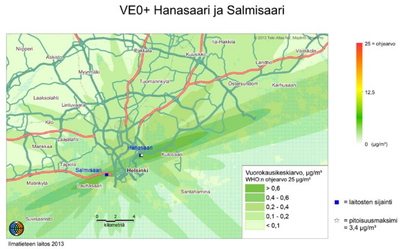
Hanasaari receives a maximum of 11 pellet deliveries per day and Salmisaari max 14/d.[1]
| Option | Fly ash (t/a) | Bottom ash (t/a) | Sulphur-removal end product (t/a) | Total (t/a) |
|---|---|---|---|---|
| Hanasaari power plant: biofuels 10 % | 59 000 | 12 000 | 8 000 | 79 000 |
| Salmisaari power plant: biofiels 10 % | 45 000 | 11 000 | 9 000 | 65 000 |
| Total | 104 000 | 23 000 | 17 000 | 144 000 |
| Emission source | CO2 kt/a | CO2-eqv kt/a (incl. fossil fuel ghg-emissions) | CO2-eqv kt/a (incl. fossil and biofuel emissions) |
|---|---|---|---|
| Power plant emissions | 2 524 | 2 533 | 2 687 |
| Emissions from fuel transport | 8 | ||
| Total | 2 540 | 2 700 |
| Power plant | NO2 (t/a) | SO2 (t/a) | Particles (t/a) |
| Salmisaari A and B | 946 | 996 | 92 |
| Fly ash (t) | Bottom ash (t) | Sulphur removal end product (t) | Total (t) | |
|---|---|---|---|---|
| Salmisaari power plants: 10 % bio, 90 % coal | 45 000 | 11 000 | 9 000 | 65 000 |
Emission coefficients
Cost
No building cost, because nothing is renovated nor built.
Usage cost
Production
How much energy?
| Electricity MW | Heat MW | Fuel | |
|---|---|---|---|
| Hanasaari | 220 | 420 | coal, pellets |
| Salmisaari | 160 | 300 | coal, pellets |
| Total | 380 | 720 |
Same table as in VE2(?), because same power plants will be in use.
Helen's suggestion: New heat plants
Helen's new option in June 2015: a distributed model based on separate heat production
- The investments necessary are flexible and distributed solutions
- The oil heat plant in Salmisaari is replaced by a new about 100 MW pellet heat plant, what can be taken into use in 2017.
- A new bio heat plant is built in Vuosaari and possibly also somewhere else.
- The bio heat plants use pellets and/or wood chips as fuel. The use of biocoal is also possible.
- The option enables different energy efficiency solutions and new ways to produce heat (heat pumps, solar heat, geothermal heat...), that are taken into use slowly as the conditions change to enable their use. Both Helen and other, for example home-owners, can take these new technologies into use.
- The option helps achieve the goals for reducing emissions and increasing renewable energy.
- The challenges to increasing the use of biofuels have to do with their availability, acceptability and price.
- The option is somewhat against the city council's energy policy, because it replaces CHP with the separate production of heat. Helen still thinks this is a feasible option in the future's energy markets. According to international analysis data the price for electricity will remain so low for so long new investments in CHP isn't worth it. Even with this option Helen is left with a lot of CHP capacity, so the decrease in CHP would remain relatively small.
- The option includes the possibility to built a CHP plant in Vuosaari in the future.
- When the bio heat plants are taken into use and the necessary heat production capacity is ensured in the beginning of 2020's, it is possible to give up the Hanasaari CHP plant. If this is done, the majority of the plant area would be freed for other uses. Also the bridge between Sompasaari and Kruunuhaka could be built.
- According tothe environmental impact assessment the option is feasible.
- The investments required by the option are approximately 360 million euros. The total cost of the option is lowest of all the options that were looked into.
Effects:
- Emissions
- Cost
- Running level
- Jobs in construction
- Decicion-maker: Helsinki city
Vuosaari
A new power plant is built in Vuosaari. The new plant (Vuosaari C) can burn any ratio of biofuel to coal. An energy tunnel is built from Vuosaari to Hanasaari to transport the energy to Helsinki city center.
Effects:
- Emissions
- Cost
- Traffic
- Noise (Natura 2000 -area nearby)
- Air quality
- Forests close by and further away in Finland
- Drawing closer to the coal-neutrality goal
- Running level
- Jobs in construction
- Decision-maker: Helsinki city, Helen
Description
The plans for power plant Vuosaari C are based on the assumption, that the plant will mostly use biofuels (max 80%) and coal (20%). The planned fuels are wood chips and pellets as well as small amounts of agro-biomass. The use of biochar is also possible.[1] The plan is to get 60 % of the biofuel from Finland.[2]
The plant will be fitted with a boiler developed for biofuel combustion (specifically kiertoleijupetikattila ). In order to ensure stable levels of district heat the plant is planned so, that it can function using coal only. Nevertheless plans can be made to enable the use 100 % biofuels. The recent Environmental Impact Assessment (EIA) compared the options of burning 100 % biofuels with the extreme option of burning 100 5 coal.[1]
Three options are considered for the Vuosaari powerplant (in this option, Salmisaari always burns 95% coal and 5% biofuels):
- V1: 80% biofuels, 20% coal
- V2: 100% biomass
- V3: 100% coal
At the same time Helsinki is planning a 12 kilometres long energy tunnel from Vuosaari to Hanasaari. It would be quarried in bedrock and provide district heating and possibly electricity for the needs of the whole city. The warehouses for fuel, locations for unloading trains and trucks and conveyor would be built next to the plant, and possibly a road for crossing the train tracks as well.[1]
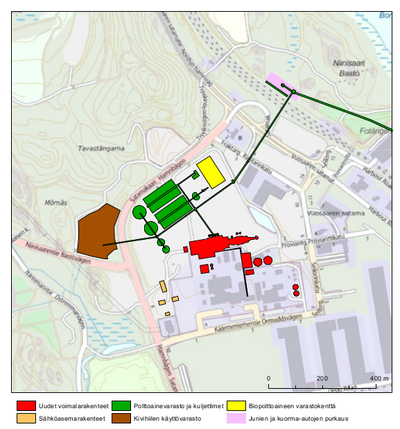
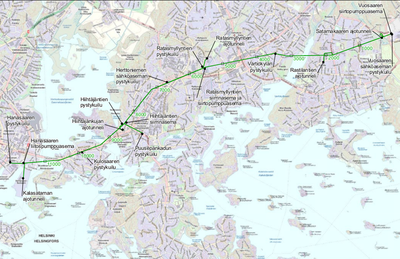
Emissions
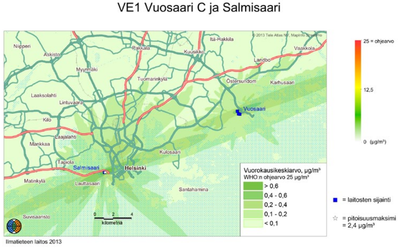
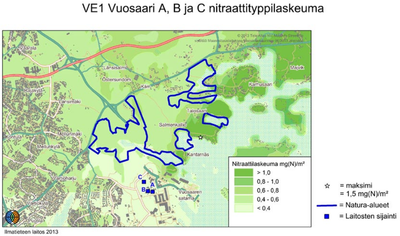
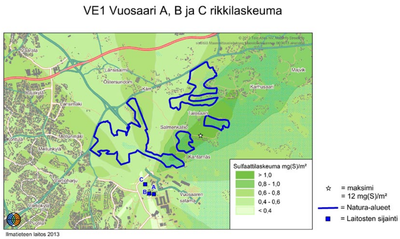
The emissions from the new plant would have two main sources: combustion of biofuels and coal and from transporting those fuels to Vuosaari C.
The fuel will be brought to the plant by ship, barge, train and truck. Ships and barges will be used to transport biofuel, coal and oil. Trains and trucks will mainly be used for transporting biofuels, trains also for transporting coal. Because the amounts of fuel required by the C-plant will be substantial, the fuel shipments will mostly be carried out using ships. Trains and trucks will be a supplementary means of transport. Shipments can be brought 24/7.[1]
Flue gases will be conducted to flue gas purification, where the particles are remowed, after which the flue gases are directed through flue gas blowers into the chimney. The ashes from the fuel are remowed as bottom ash from the furnace and as fly ash in the flue gas purification.
The power plant's flue gases are purified efficiently, so harmful effects to nearby vegetation remain slight. The great height of the chimney aids in the effective dilution of emissions in the air, so the effects on local concentrations are minimized. Judging by the atmospheric fate and transport (AFT) modeling's calculations, the new power plant C would cause only a minimal increase in air impurity levels in the metropolitan area. It is estimated that the fallout wont have harmful impacts on the vegetation of Natura-areas in Östersundom bird waters and Mustavuori grove nor further away north-east in Sipoonkorpi's Natura-area.[1]
Judging by the AFT-modeling's results, the nitrogen oxide-, sulfur oxide- or particulate matter emissions from the normal operation of Helsingin Energia's powerplants do not cause a health risk to the residents in the neighbouring area. In each Vuosaari option the plants' emission levels are lower than the recommended values and limit values for air quality, which have been decreed in order to protect health. In evaluating the results of the AFT-modeling it needs to be considered, that the enviromental impact assessment (EIA) did not review the plants' possible emissions in a fault situation or the combined impact on air quality of the plants and other sources of emissions in te area.[1]
| Power plant | NO2 (t/a) | SO2 (t/a) | Particles (t/a) |
|---|---|---|---|
| Vuosaari C | 853 | 853 | 57 |
| Vuosaari A and B | 550 | - | - |
| Total | 2 349 | 1 849 | 149 |
| Sub-option | Fly ash (t) | Bottom ash (t) | Sulphur removal end product (t) | Total (t) |
|---|---|---|---|---|
| V1 80 % bio, 20 % coal | 59 000 | 10 000 | - | 69 000 |
| V2 100 % bio (10 % pellet, 90 % chips) | 52 000 | 9 800 | - | 62 000 |
| V3 100 % coal | 82 000 | 52 000 | - | 134 000 |
| CO2, kt/a | CO2-ekv, kt/a (incl. fossilfuel ghg emissions) | CO2-ekv, kt/a (incl. fossilfuel and biofuel emissions) | |
|---|---|---|---|
| V1 powerplant emissions | 1 468 | 1 402 | 3 061 |
| V2 powerplant emissions | 1 073 | 1 114 | 3 090 |
| V3 powerplant emissions | 2 722 | 2 882 | 2 947 |
| V1 fuel transport emissions | 15 | ||
| V2 fuel transport emissions | 23 | ||
| V3 fuel transport emissions | 6 | ||
| V1 total emissions | 1 480 | 3 080 | |
| V2 total emissions | 1 140 | 3 110 | |
| V3 total emissions | 2 890 | 2 950 |
Cost
Building cost
The recent Environmental Impact Assessment takes a quick look at the different energy investment options' economic effects. A project plan will made later in 2015 and give more precise details on the economic effects. Building the new power plant would probably be twice as expensive as making the necessary changes in the old plants. Assessing the economic effects is not simple, however. Using the Vuosaari C plant would be tens of millions cheaper yearly than using the overhauled Hanasaari and Salmisaari plants. The city of Helsinki will lose money also if they can not build a new residential area in Hanasaari as planned.[2]
The power plant itself will cost approximately 650 million euros and the energy tunnel 180 million euros. An estimate (2011) of the total costs is 1,2 billion.[3]
Usage cost
If the Vuosaari C powerplant uses 100 % biofuels (ratio: 90 % wood chips to 10 % pellets), it would mean an annual fuel amount of 1,8 million tons wood chips and 103 000 tons pellets.
If the portion of biofuels is 80 % (ratio: 90 % wood chips to 10 % pellets), it would mean an annual fuel amount of 1,46 million tons wood chips, 82 000 tons pellets and 140 000 tons coal.
If the Vuosaari C powerplant uses coal only, it would need 660 000 tons of it per year.[1]
The export price on wood pellets is 133 €/t [1].
The price of wood chips is 20€/MWh? [2][3]
According to this page, the thermal coal CAPP price is about 50 €/metric tonne.
| Coal | Wood chips | Wood pellet | ||
| Fuel consumption | t/h | 0–108 | 0–334 | 0–178 |
| Fuel consumption | m3/h | 0–135 | 0–1 113 | 0–255 |
Calculations:
If 100% coal is used in Vuosaari power plant
- 660 000 t/a * 50 €/t = 33 000 000 €/a
If only 20% coal was used:
- coal: 140 000 t/a * 50€/t = 7 000 000 €/a
- pellets: 82 000 t/a * 133 €/t = 10 906 000 €/t
- hake: 1 460 000 t/a * €/t =
If only biofuels were used:
- hake: 1 800 000 t/a * €/t =
- pellets: 103 000 t/a * 133 €/t = 13 699 000 €/a
Production
The annual fuel consumption will be approximately 4 TWh depending on the year and the way the plant is run.[1] The new plant's district heat output would be around 350 MW and electricity output 200 MW.[4]
Around 40-50 % of the heat is conducted to the furnaces' walls and the possible superheater. The rest of the heat is transferred in the convection part.[1]
Effects to Natura 2000 area
The wind predominantly blows from south-west. The noise barrier in the harbour and especially the wooded area in Niinisaari limit the spread of emissions towards north-east and e.g. the Natura area. The vegetation binds dust especially in summer time.[1]
Hanasaari shutdown
Hanasaari power plant is shut down and demolished. Apartment buildings are constructed in its place.
Effects:
- Emissions
- Cost
- Land use near city center
- Market rates for apartments in Helsinki
- Quality of inner city environment
- Running level
- Jobs in construction
- Decision-maker: Helsinki city, Helen
Emissions
Cost
Hanasaari 40 biofuel
Hanasaari power plant is renovated to burn 40% biofuels among coal.
Effects:
- Emissions
- Cost
- Forests around Finland
- Running level
- Economy of cities selling biofuels
- Jobs in construction
- Decision-maker: Helsinki city, Helen

Emissions
Pellets are transported to Hanasaari mainly by ship. An estimated 18 truckloads of pellet would come to Hanasaari each day. Approximately 100 ships annually would ship coal and pellets to Hanasaari.[1]
A research paper published in 2014 assessed the net environmental impacts of the co-combustion and changes in urban air quality connected to pellet transport, and aimed to identify environmental hotspots relevant to possible future higher-share co-combustion. The applied methods were screening LCA (life cycle assessment) and fine particle dispersion modelling. Its results were that low-share wood pellet co-combustion in CHP production leads to net environmental impact reductions and does not deteriorate air quality in the urban environment. If higher-share co-combustion were to be implemented, the environmental hotspots to focus on would be the operational issues of a power plant and the origin and sustainability aspects of wood pellet production.[5]
| NO2 (t/a) | SO2 (t/a) | Particles (t/a) | |
| Hanasaari B | 1 224 | 1 224 | 122 |
| Fly ash (t/a) | Bottom ash (t/a) | Sulphur removal end product (t/a) | Total (t/a) | |
| Hanasaari power plant: 40 % biofuels, 60 % coal | 40 000 | 9 000 | 6 000 | 54 000 |
| CO2, kt/a | CO2-eqv, kt/a (incl. fossilfuel ghg-emissions) | CO2-ekv, kt/a (incl. fossilfuel and biofuel emissions) | |
| Power plant emissions | 1 594 | 1 606 | 2 837 |
| Fuel transport emissions | 11 | ||
| Total | 1 620 | 2 850 |
Emission coefficients
Cost
Building cost
The powerplant by itself would cost 100 million euros, the total effect on Helsingin Energia's investment costs would be 500 million (an estimate of 2011).[3]
Usage cost
In the option Hanasaari 40 % biofuel the plabt uses around 390 000 tons coal and 380 000 tons pellet per year. An estimated 11 500 tons of oil per year would be used as support and back-up fuel.[1]
Production
| Electricity MW | Heat MW | Fuel | |
|---|---|---|---|
| Hanasaari | 220 | 420 | coal, pellets |
Salmisaari 40 biofuel
Salmisaari power plant is renovated to burn 40% biofuels among coal.
Effects:
- Emissions
- Cost
- Forests around Finland
- Running level
- Economy of cities selling biofuels
- Jobs in construction
- Decision-maker: Helsinki city, Helen
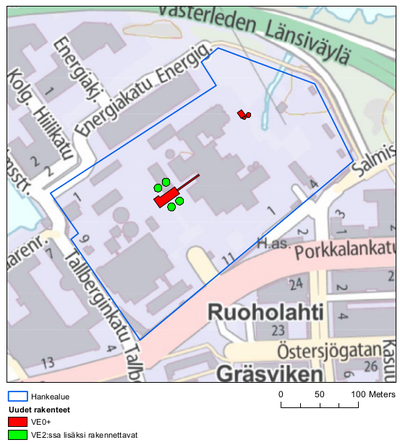
The pellets are transported to Salmisaari power plant by truck. The estimate is, that to burn 40 % biofuels it would need 53 truck shipments of pellets per day. Helsingin Energia is looking into an option, where the pellets to Salmisaari would be brought also through Hanasaari harbour. If all pellets for Salmisaari's use were transported through Hanasaari, the number of ships coming to its harbour transporting coal and pellets would increase by 90 per year.[1]
Emissions
| Power plant unit | NO2 (t/a) | SO2 (t/a) | Particles (t/a) |
| Salmisaari A and B | 946 | 996 | 92 |
| Fly ash (t/a) | Bottom ash (t/a) | Sulphur removal end product (t/a) | Total (t/a) | |
| Salmisaari power plant: 40 % biofuels, 60 % coal | 30 000 | 8 000 | 6 000 | 44 000 |
| CO2, kt/a | CO2-eqv, kt/a (incl. fossilfuel ghg-emissions) | CO2-ekv, kt/a (incl. fossilfuel and biofuel emissions) | |
|---|---|---|---|
| Power plant emissions | 1 594 | 1 606 | 2 837 |
| Fuel transport emissions | 11 | ||
| Total | 1 620 | 2 850 |
The Salmisaari plant uses around 290 000 tons coal and 280 000 tons pellet per year. Approximately 11 500 tons of oil per year are used as support and back-up fuel.[1]
| Electricity MW | Heat MW | Fuel | |
|---|---|---|---|
| Salmisaari | 160 | 300 | coal, pellets |
Cost
Production
Biofueled heat production units
Salmisaari oilfueled heat plant is shut down and new biofuel burning heat plants are built in Salmisaari and Vuorsaari.
Effects:
- Emissions
- Cost
- Forests around Finland
- Running level
- Economy of cities selling biofuels
- Jobs in construction
- Decision-maker: Helsinki city, Helen
Salmisaaren öljylämpökeskus korvataan uudella pellettilämpölaitoksella, joka voidaan ottaa käyttöön jo vuonna 2017. Laitoksen teho on noin 100 MW. Rakennetaan Vuosaaren voimalaitosalueelle ja mahdollisesti muulle laitospaikalle uusi biolämpölaitos. Biolämpölaitosten polttoaineina käytetään pellettiä ja/tai haketta. Myös biohiilen käyttö on mahdollista.
Vaihtoehdon toteutus mahdollistaa erilaiset energiatehokkuusratkaisut sekä uudet lämmöntuotantoratkaisut (esim. lämpöpumput, aurinkolämpö ja geoterminen lämpö), joita toteutetaan vaiheittain niiden toteuttamisedellytysten täyttyessä. Näitä ratkaisuja voivat olla toteuttamassa sekä Helen että muut toimijat, mm. kiinteistöjen omistajat.
Vaihtoehdossa säilytetään mahdollisuus rakentaa Vuosaaren alueelle tulevaisuudessa yhteistuotantovoimalaitos. Kun biolämpölaitokset on otettu käyttöön ja riittävä lämmöntuotantokapasiteetti on pystytty varmistamaan 2020-luvun alkupuolella, Hanasaaren yhteistuotantovoimalaitoksen toiminnasta olisi mahdollista luopua. Tällöin valtaosa voimalaitosalueesta vapautuisi muuhun käyttöön. Myös siltayhteys Sompasaaren ja Kruununhaan välillä (Kruununhaka – Nihti -silta) olisi tällöin mahdollista toteuttaa. Ympäristövaikutusten arvioinnin perusteella vaihtoehto on mahdollista toteuttaa.
Vaihtoehdon toteutuksen edellyttämät investoinnit ovat noin 360 miljoonaa euroa. Kokonaiskustannuksiltaan vaihtoehto on selvitetyistä vaihtoehdoista edullisin. [7].
Lisätietoa Helenin blogissa ja HS:n uutisessa.
Loviisa nuclear CHP
A new nuclear power plant is built in Loviisa and used for district heating in Helsinki.
Effects:
- Emissions
- Cost
- Nuclear waste
- Perceived safety
- Running level
- Jobs in construction
- Decision-maker: Helsinki city, Fortum, Loviisa city?
The plant would have a light water reactor (LWR), which would produce heat at a maximum of 4600 MW and the net electric power would be 1000-1800 MW. If the plant would produce district heating too, its electric power would be 800-1600 MW and the district heating power 1000 MW. [8]
Building a tunnel and pipe for district heat from Loviisa to Helsinki would cost approximately 700 million euros and the changes to the nuclear plant would cost approximately 500 million euros. The total costs of the plant are between 4 and 6 billion euros. Using the plant for district heating also would decrease the plant's electric power somewhat, but as a whole the cost price of nuclear district heat would be 16 €/MW. [9]
According to Pöyry's report, nuclear district heat would be the most expensive of the reviewed options. The options reviewd in the report were renovating Hanasaari and Salmisaari, demolishing Hanasaari and building Vuosaari C, and decentralised renewable energy production. Based on the report, nuclear district heat would have the greatest financial risk and implementational problems.[10]
Background info: A newspaper article from 2007 that tells about possible nuclear heat production in Loviisa ![]() Loviisa_wasteheat_article
Loviisa_wasteheat_article
Neste excess heat
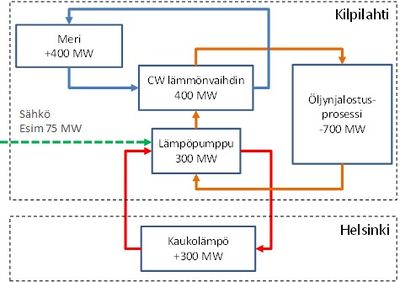
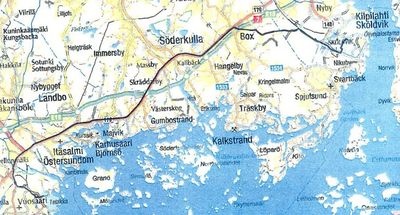
Excess heat from Neste's oil refinery in Porvoo is used for district heating in Helsinki.
Effects:
- Cost
- Running level
- Jobs in construction
- Decision-maker: Helsinki city, Neste
Neste oil refinery produces a lot of excess heat, which is now transferred trough the coolant water -network to the sea. The coolant water in the area is 20-30 C and the heat is transferred at approximately 700 MW. In practice the maximum capacity that could technically be transferred is approximately 300 MW. This power level can be delivered year-round as a constant base capacity.
Transferring the heat to Helsinki does not directly increase CO2-emissions. Raising the water-temperature to usable levels requires electricity, however, which might increase indirect emissions.
The are some challenges to this option, such as the investment cost and the heat-pump technology. The scale of the heat capacity to be transferred and fitting the heat pumps in the refinery environment pose challenges to the planners. The needed investments would include the heat pumps, strengthening the grid in Kilpilahti, building the main transfer-pipe from Kilpilahti to Vuosaari, strengthening the district heat network between Vuosaari and Helsinki city centre. The total investment cost is 200-500 M€.
Neste is interested in finding out about possibilities for cooperation with Helsinki.
- Source of overall plan:
 Kaukolampo_Kilpilahti-Helsinki
Kaukolampo_Kilpilahti-Helsinki
Decentralised energy production
Small-scale energy production units are built around Helsinki, such as heat pumps, geothermal, sun panels, wood burners and wind mills for producing energy for a single building.
Effects:
- Emissions
- Cost
- Running level
- Tourism & image
- Jobs in construction
- Jobs in research?
- Decision-maker: Helsinki city, Citizens
Large heat pumps
Heat pumps are installed to draw large amounts of heat from the Gulf of Finland (similar system as in Stockholm) or from deep drilled hole from the ground (similar system as piloted in Espoo).
Effects:
- Emissions
- Cost
- Baltic sea
- Running level
- Environmental and political concerns
- Tourism & Finland's imago
- Jobs in construction
- Decision-maker: Helsinki city
Energy saving
Buildings in Helsinki are renovated, big campaigns to affect attitudes are organised and zero-energy houses are built to reduce the consumption of power significantly.
Effects:
- Emissions
- Cost
- Tourism & Finland's imago
- Running level
- Jobs in construction
- Decicion-maker: Helsinki city, Citizens
See also
- Net environmental impacts of low-share wood pellet co-combustion in an existing coal-fired CHP (combined heat and power) production in Helsinki, Finland[5]
- Helsingin parhaat energiatehokkuuskäytännöt -työryhmän loppuraportti 2011
----#: . Along with the two main options there has just recently been proposed another option by HELEN itself at the end of July (the energy production would rely on decentralized renewable sources). Decentralized means in this case smaller power-plant units rather than really decentralized production at household-level, as far as I have understood. Have you taken this into account yet? The assessment on the decentralized energy production that is being done at the moment concentrates more on the small-scale production. --Signatiu (talk) 13:09, 7 July 2015 (UTC) (type: truth; paradigms: science: comment)
- http://www.hs.fi/kaupunki/a1434165018496
- http://www.hs.fi/kaupunki/a1434593799477
- http://www.hs.fi/kaupunki/a1305963824515
- http://www.hs.fi/kaupunki/a1434510019963?ref=hs-art-artikkeli
References
- ↑ 1.00 1.01 1.02 1.03 1.04 1.05 1.06 1.07 1.08 1.09 1.10 1.11 1.12 1.13 1.14 1.15 1.16 1.17 1.18 1.19 1.20 1.21 1.22 1.23 1.24 1.25 1.26 1.27 1.28 1.29 1.30 1.31 1.32 1.33 1.34 1.35 1.36 1.37 1.38 Helsingin Energian biopolttoaineiden käytön lisääminen, Helsinki YVA 2013
- ↑ 2.0 2.1 Helsingin Sanomat: Helsingin vaihtoehdot: Kallis voimala luonnonsuojelualueen viereen tai Hanasaari ilman asuntoja
- ↑ 3.0 3.1 Helsingin Sanomat: Näistä isoista investoinneista päätetään
- ↑ Helsingin Energia
- ↑ 5.0 5.1 Jáchym Judl, Sirkka Koskela, Timo Korpela, Niko Karvosenoja, Anna Häyrinen, Jari Rantsi. Net environmental impacts of low-share wood pellet co-combustion in an existing coal-fired CHP (combined heat and power) production in Helsinki, Finland. Energy 77 (2014) 844-851. doi:10.1016/j.energy.2014.09.068
- ↑ Helen: Hanasaaren voimala
- ↑ Helen 17.06.2015Uusi hajautettu malli hiilidioksidipäästöjen vähentämiseen
- ↑ Loviisa 3 periaatepäätös 13.5.2010
- ↑ Loviisan Sanomat 19.10.2007 Loviisan uuden ydinvoimalan hukkalämmöllä lämmittäisi koko Helsingin
- ↑ Helsingin Energian kehitysohjelma kohti hiilineutraalia tulevaisuutta 2010